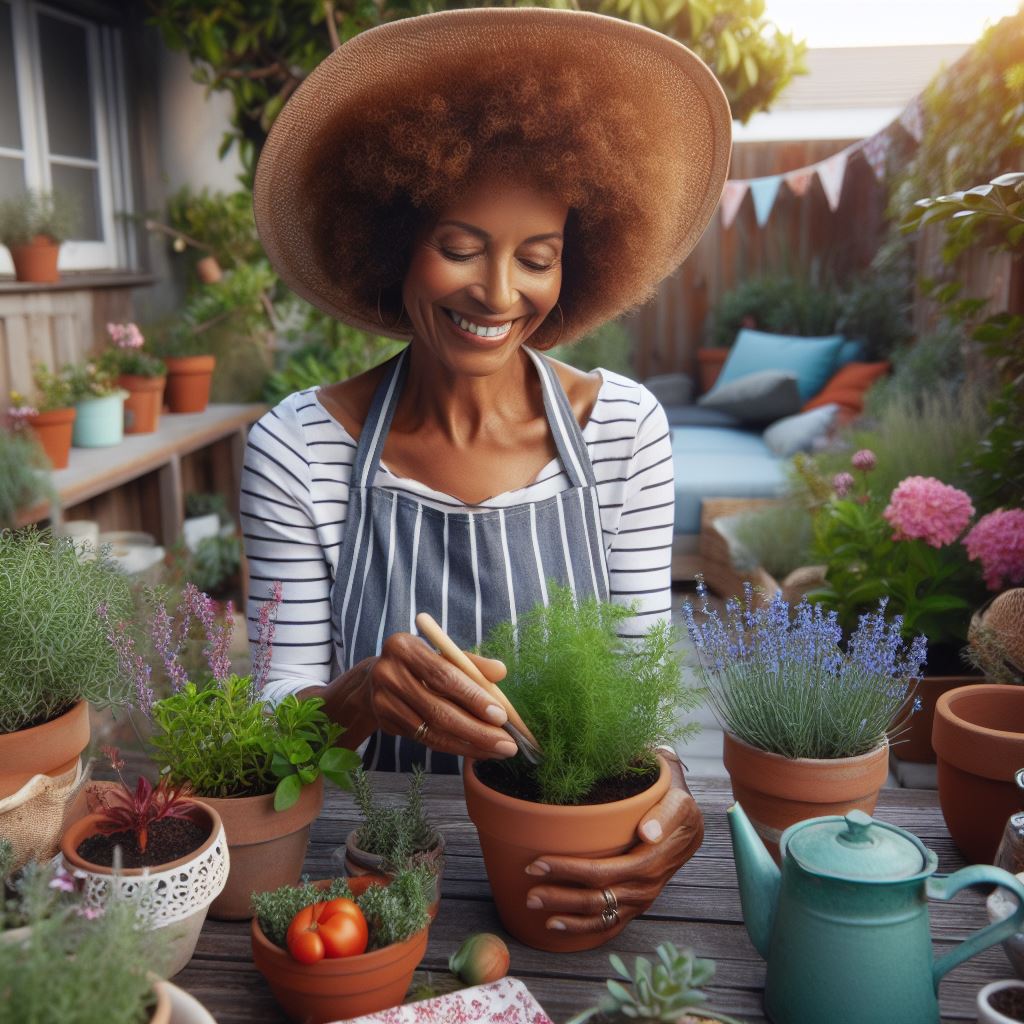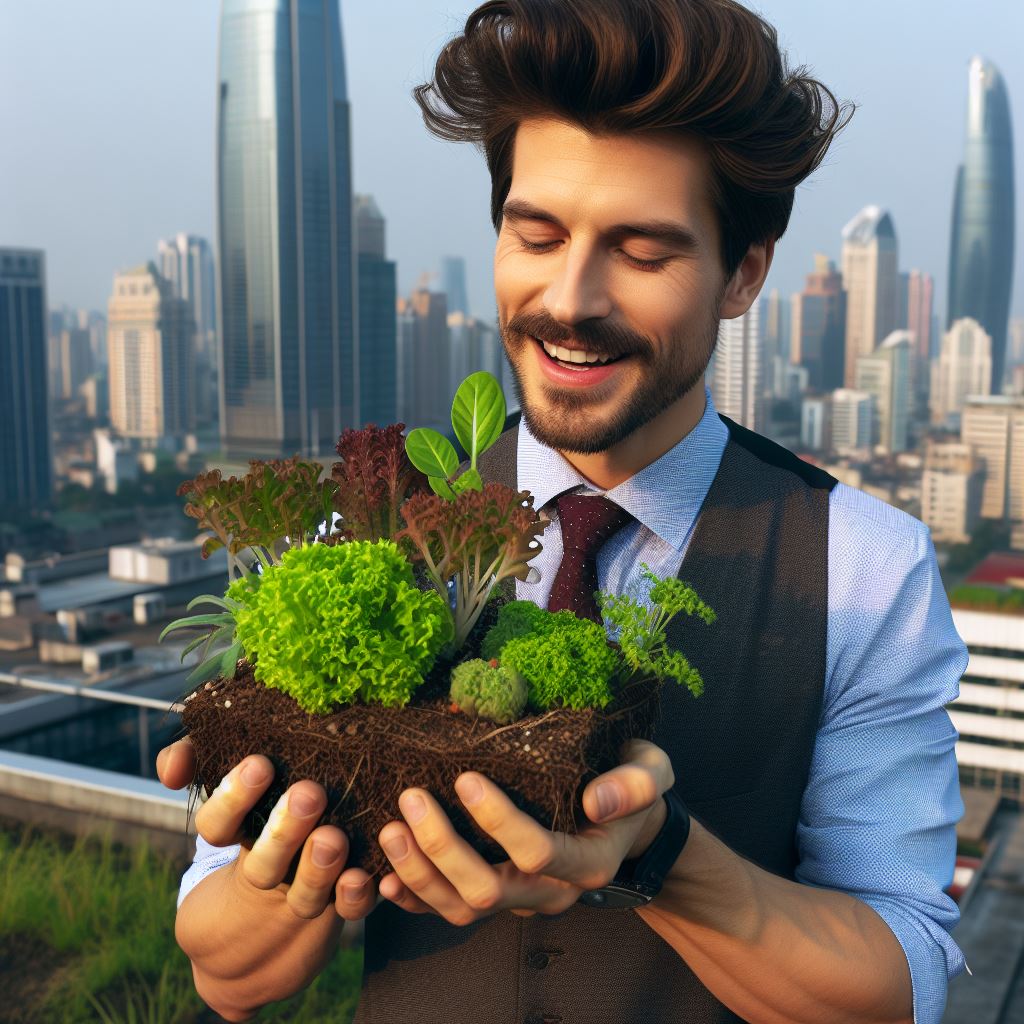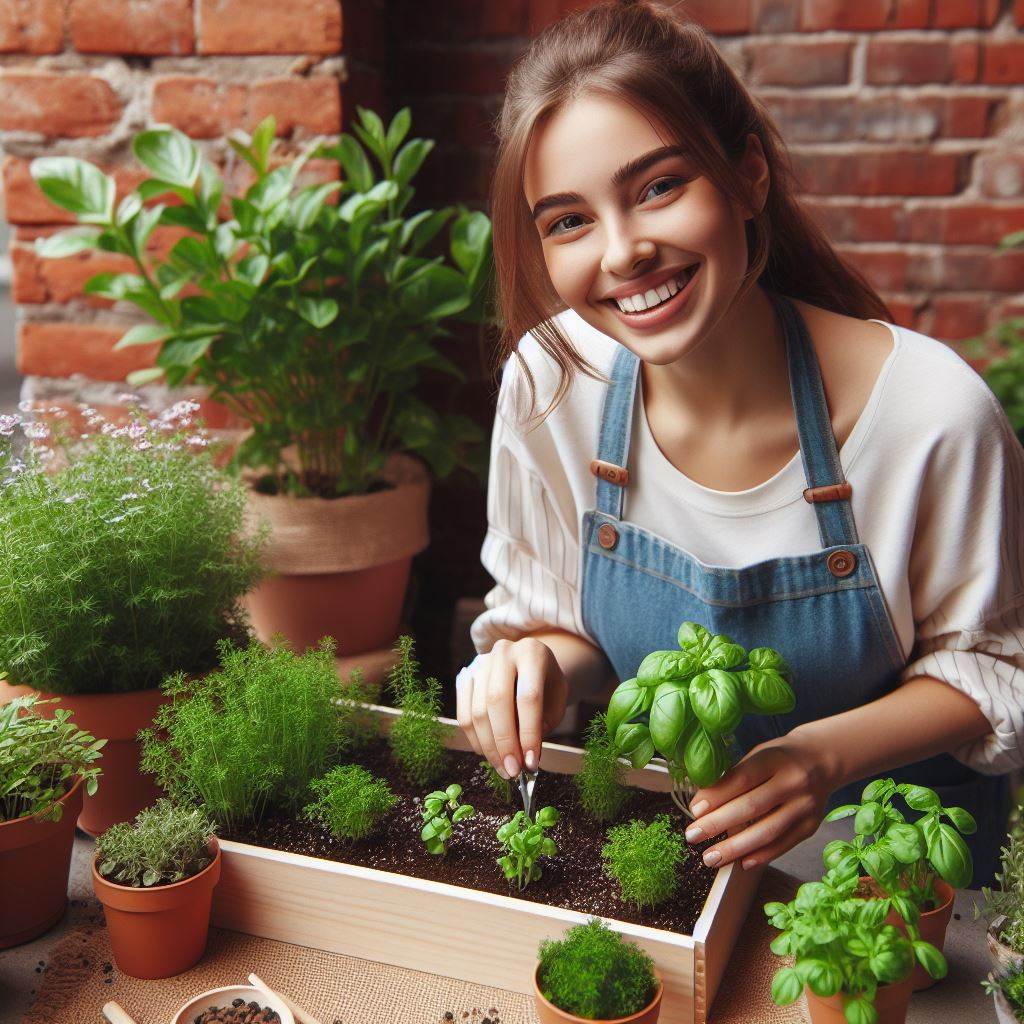Introduction
Are you looking for a simple and convenient way to grow your own herbs?
Look no further than a patio herb garden.
A patio herb garden is a small garden that is specifically designed to grow herbs in limited space, such as a patio or balcony.
Having a patio herb garden brings many benefits.
First, it provides easy access to fresh herbs, right at your doorstep.
You can simply step outside and pick a few herbs to add flavor to your dishes.
It saves money and ensures you always have fresh herbs on hand.
Second, a patio herb garden adds beauty and fragrance to your outdoor space, creating a welcoming and pleasant environment.
Imagine the aroma of fresh basil or mint wafting through your patio, enhancing the overall ambiance.
Third, growing your own herbs allows you to have control over what goes into your food.
You can ensure that your herbs are organic and free from harmful pesticides. It promotes a healthier lifestyle.
Additionally, tending to a patio herb garden can be therapeutic and rewarding.
It provides a sense of accomplishment and relaxation.
Even if you are a beginner, you can start a patio herb garden with simple steps and minimal effort.
In the following sections, we will guide you through the process, from choosing the right herbs to maintaining your garden.
Transform Your Agribusiness
Unlock your farm's potential with expert advice tailored to your needs. Get actionable steps that drive real results.
Get StartedGet ready to experience the joys and benefits of having your own patio herb garden. Let’s get started!
Choosing the right location for your patio herb garden
Choosing the right location for your patio herb garden is crucial for its success.
Here are some factors to consider:
- Amount of sunlight: Before setting up your herb garden, assess how much sunlight your patio receives. Most herbs require at least six hours of direct sunlight daily. Choose a spot that gets adequate sunlight throughout the day.
- Space availability: Determine the available space on your patio for the herb garden. Consider the size and number of pots or containers you can accommodate. Make sure there is enough room for your herbs to grow and flourish.
- Proper drainage: Discuss the importance of proper drainage for your patio herb garden. Excess water can cause root rot and damage your plants. Ensure that your pots have drainage holes and use well-draining soil to prevent waterlogging.
Additional tips for creating a successful patio herb garden
Creating a successful patio herb garden requires careful planning and consideration.
Here are some additional tips to help you get started:
- Evaluate your herb choices: Choose herbs that thrive in your climate and are suitable for container gardening. Some popular patio herbs include basil, thyme, rosemary, mint, and parsley.
- Select the right containers: Use pots or containers that are suitable for your chosen herbs. Consider the size, material, and design of the containers. Ensure they have drainage holes and are large enough for the herbs to grow comfortably.
- Prepare the soil: Use a high-quality potting mix that is specifically formulated for container gardening. These mixes provide excellent drainage and retain moisture, promoting healthy root growth.
- Planting and spacing: Follow the planting guidelines for each herb. Start by filling the container with soil, leaving enough space for the plants’ roots. Place the herbs in the containers, ensuring proper spacing between each plant to allow for airflow and prevent overcrowding.
- Watering and maintenance: Water your herbs regularly, ensuring the soil remains moist but not waterlogged. Most herbs prefer slightly drier soil between waterings. Regularly check for pests, diseases, and signs of nutrient deficiency. Trim and harvest the herbs to promote growth and maintain their shape.
- Consider companion planting: Some herbs benefit from being planted near each other. For example, basil and tomatoes are natural companions. Research companion planting to maximize the health and productivity of your herb garden.
Additional tips
- Protect from extreme weather: During hot summer days, move your pots to a shaded area to prevent scorching. Similarly, if frost is expected, transfer the plants indoors or cover them with frost cloth to protect them from cold damage.
- Regularly fertilize: Herbs benefit from regular fertilization. Use organic fertilizers or slow-release granules to nourish the plants. Follow the recommended dosage and frequency depending on the specific herbs you are growing.
- Harvesting your herbs: Enjoy the fruits of your labor by harvesting your herbs regularly. Harvest in the morning when the essential oils are at their peak. Pinch or cut the herbs just above a leaf node to encourage bushier growth.
In short, starting a patio herb garden involves choosing the right location, assessing sunlight, considering space availability, and ensuring proper drainage.
Remember to select suitable herbs, containers, soil, and implement proper care and maintenance practices for a thriving herb garden on your patio.
Read: Water Works: Basics of Home Aquaponics
Selecting the herbs for your garden
Popular herbs suitable for patio gardens
- Basil: Requires full sun, well-drained soil, and regular watering. It’s perfect for adding flavor to various dishes.
- Rosemary: Thrives in dry soil and prefers full sun. It’s an aromatic herb commonly used in Mediterranean cuisine.
- Mint: Grows well in pots but needs regular watering. It’s great for making refreshing drinks and adding to desserts.
- Thyme: Requires well-drained soil and full sun. This versatile herb is used in a wide range of savory dishes.
- Parsley: Grows best in partial shade and moist soil. It’s commonly used as a garnish and adds freshness to recipes.
- Chives: Prefers full sun or partial shade and needs regular watering. Chives have a mild onion-like flavor and are perfect for salads and soups.
- Oregano: Thrives in well-draining soil and full sun. It’s a staple in Italian cuisine, used in pasta sauces and pizza.
- Dill: Requires full sun and regular watering. Dill is known for its distinct flavor and is commonly used in pickling and seafood dishes.
- Cilantro: Grows best in partial sun and moist soil. It’s commonly used in Mexican and Asian cuisines.
- Sage: Prefers full sun and well-drained soil. Sage adds a savory flavor to dishes and is often used in stuffing.
- Lavender: Requires well-drained soil and full sun. Lavender is not only aromatic but can also be used in baking and infusions.
Their requirements and growth habits
Each herb has specific requirements and growth habits that need to be considered when planning a patio herb garden.
- Sunlight: Most herbs prefer full sun and need at least 6 hours of direct sunlight daily. However, some herbs, like parsley and cilantro, tolerate partial shade.
- Soil: Well-drained soil is essential for herbs to thrive. Adding compost or organic matter can improve the soil’s texture and fertility.
- Watering: Most herbs prefer evenly moist soil, but overwatering can lead to root rot. It’s crucial to water herbs when the top inch of soil feels dry.
- Container size: Choose the appropriate size containers according to the herb’s growth habit. Some herbs, like mint, have invasive root systems and require larger pots.
- Pruning and harvesting: Regular pruning promotes bushier growth and prevents herbs from becoming excessively leggy. Harvesting should be done by cutting stems or leaves close to the base.
Considering the herbs commonly used in cooking
- Basil: Often used in Italian and Thai cuisines, basil adds a sweet and aromatic flavor to dishes like pasta and stir-fries.
- Rosemary: Known for its pine-like fragrance, rosemary is a popular herb used in roasted meats, potatoes, and marinades.
- Mint: The refreshing taste of mint is perfect for beverages like mojitos and mint juleps, as well as for flavoring desserts and salads.
- Thyme: Widely used in French and Mediterranean cuisines, thyme enhances the flavor of roasted vegetables, stews, and soups.
- Parsley: This versatile herb is a common garnish but can also be used in sauces, salads, and as a flavoring in various recipes.
- Chives: Chives add a mild onion-like flavor to salads, omelets, and cream-based sauces.
- Oregano: A staple in Italian and Greek dishes, oregano is commonly used in pizza, pasta sauces, and grilled meat marinades.
- Dill: Dill’s distinctive flavor complements fish, pickles, salads, and creamy sauces.
- Cilantro: Commonly used in Mexican and Asian cuisines, cilantro adds a fresh and citrusy flavor to salsas, curries, and soups.
- Sage: Often used in Thanksgiving stuffing, sage pairs well with poultry, pork, and butternut squash dishes.
- Lavender: Although not common in cooking, lavender can add a unique floral flavor to baked goods, syrups, and teas.
Essentially, selecting the right herbs for your patio garden involves considering their suitability for containers, their growth habits, and their culinary uses.
With proper attention to their requirements, you can create a thriving and functional patio herb garden for culinary delights.
Read: Hydroponics vs. Soil: What’s Best for You?
Container Selection and Preparation
Types of containers for patio herb gardens
- Terracotta pots: provide a classic look and excellent drainage for herbs.
- Plastic containers: lightweight and inexpensive, with good moisture retention.
- Hanging baskets: perfect for small spaces and trailing herbs like thyme or oregano.
Choosing the right size and material
- Consider the mature size of your herbs and choose containers that accommodate their growth.
- Look for containers made of sturdy materials that can withstand outdoor conditions.
- Avoid containers with narrow openings that can restrict root growth.
Tips for preparing the containers for planting
- Clean the containers with warm, soapy water to remove any dirt or debris.
- Rinse thoroughly and allow them to dry completely before use.
- If reusing old containers, sanitize them by soaking in a solution of one-part bleach to nine parts water.
Preparing the containers
- Fill the bottom of the containers with a layer of small rocks or pebbles for drainage.
- Add a layer of potting soil, leaving enough space for the herb’s roots.
- Gently remove the herb from its nursery container, taking care not to damage the roots.
- Place the herb in the prepared container, ensuring it sits at the same depth as before.
- Fill the remaining space with potting soil, pressing lightly to secure the herb in place.
- Water the herb thoroughly after planting to settle the soil and hydrate the roots.
- Place the container in a location that receives adequate sunlight for the specific herb’s needs.
Additional tips
- Group herbs with similar sunlight and watering requirements together for optimal growth.
- Consider using self-watering containers or adding water-absorbing crystals to maintain proper moisture levels.
- Regularly monitor the moisture levels of the soil and water as needed, ensuring it doesn’t become waterlogged.
- Apply organic fertilizers or compost to provide essential nutrients for healthy herb growth.
Container selection and preparation are crucial steps when starting a patio herb garden.
By choosing the right containers and properly preparing them, you create an ideal environment for your herbs to thrive.
Remember to consider the size and material of the containers, and follow the steps for preparation.
With a little care and attention, you can enjoy fresh herbs right at your doorstep. Happy gardening!
Read: Fish-Powered Gardens: Aquaponics Guide
Soil and Fertilizer Recommendations
The ideal soil composition for herb gardens
- Herb gardens thrive in well-drained soil that is rich in organic matter.
- The ideal soil composition for herb gardens should include a mix of loam, sand, and compost.
- Loam helps retain moisture, sand improves drainage, and compost provides nutrients for healthy plant growth.
- Avoid heavy clay soils that tend to hold water, as this can lead to root rot and other plant diseases.
Importance of using well-draining soil
- Well-draining soil prevents waterlogged conditions and ensures the roots receive oxygen.
- Soil that drains well helps to prevent the rotting of herb plants’ roots.
- Proper drainage also prevents the accumulation of excess moisture, which can lead to fungal diseases.
- Using well-draining soil promotes healthy growth and overall vitality of herb plants.
Introduce organic fertilizers suitable for herb plants
- Organic fertilizers are a great choice for herb gardens as they promote sustainable and chemical-free plant growth.
- Compost is a natural and nutrient-rich fertilizer that improves soil structure and enhances plant nutrition.
- Vermicompost, which is produced by earthworms, is another excellent organic fertilizer for herb plants.
- Other options include seaweed extracts, fish emulsion, and bone meal, which provide essential nutrients to support herb growth.
- Use these organic fertilizers according to the recommended application rates to avoid overfeeding or damaging the plants.
In general, creating a successful patio herb garden starts with the right soil composition and proper fertilization.
Using a mix of loam, sand, and compost ensures ideal drainage, while organic fertilizers provide essential nutrients for healthy plant growth.
By following these soil and fertilizer recommendations, you can set your patio herb garden up for success and enjoy a bountiful harvest of fresh herbs.
Read: Indoor Eden: Hydroponic Systems for Home

Planting and Caring for Your Patio Herb Garden
One of the best ways to bring fresh flavors to your cooking is by having your own patio herb garden.
Not only does it provide you with a convenient source of herbs, but it also adds beauty to your outdoor space.
Here are some simple steps to help you get started:
Showcase Your Farming Business
Publish your professional farming services profile on our blog for a one-time fee of $200 and reach a dedicated audience of farmers and agribusiness owners.
Publish Your Profile- Choose the Right Containers: Select containers that are at least 6-8 inches deep with good drainage. You can use clay pots, plastic containers, or even repurpose old buckets or barrels.
- Prepare the Soil: Fill the containers with a well-draining potting mix. Avoid using garden soil, as it can be too heavy and may not provide the right nutrients.
- Select Your Herbs: Decide which herbs you want to grow based on your preferences and the space available. Some common choices for patio herb gardens include basil, parsley, rosemary, thyme, and mint.
- Planting: Gently remove the herbs from their nursery pots and loosen the roots before placing them in the containers. Make sure to space them out adequately to allow for proper growth.
- Watering: Water your herbs thoroughly after planting and keep the soil consistently moist but not waterlogged. Check the moisture level regularly by sticking your finger about an inch into the soil.
- Sunlight Needs: Most herbs require at least six hours of direct sunlight each day, so place your containers in a sunny spot on your patio.
Additional Steps
- Fertilizing: To ensure healthy growth, feed your herbs with a balanced organic fertilizer every four to six weeks. Follow the instructions on the fertilizer label for the correct dosage.
- Pruning: Regular pruning is essential for maintaining compact and bushy plants. Pinch back the tips of your herbs regularly to encourage branching and prevent them from becoming leggy.
- Harvesting: Harvesting your herbs frequently promotes bushier growth and ensures that you always have fresh herbs at hand. Snip off the outer leaves or sprigs, allowing the inner growth to continue flourishing.
- Winter Care: If you live in a cold climate, it’s important to protect your herbs during the winter. Either bring them indoors or cover them with a frost blanket to prevent frost damage.
Proper care and attention to your patio herb garden will reward you with a bountiful harvest and a delightful addition to your culinary endeavors.
Enjoy the fresh flavors as you create delicious meals straight from your patio!
In essence, planting and caring for a patio herb garden is an enjoyable and rewarding activity.
By following these simple steps, you can successfully grow and maintain a thriving herb garden right on your patio.
So go ahead, start your own herb garden today and enhance your culinary experience with a touch of freshness and convenience.
Troubleshooting common issues in patio herb gardens
Common pest and disease problems
- Identify pests early by regularly inspecting plants for unusual spots or holes.
- Use natural remedies like neem oil or soapy water to control common garden pests.
- Remove infected plants from the garden to prevent the spread of diseases.
- Practice crop rotation and proper spacing to minimize the risk of disease outbreaks.
- Regularly clean garden tools to avoid spreading pests and diseases between plants.
Possible nutrient deficiencies in herb plants
- Yellowing leaves may indicate a nitrogen deficiency, which can be solved by adding organic compost.
- Pale leaves with green veins may suggest an iron deficiency, easily remedied with iron-rich fertilizers.
- Stunted growth could point to a lack of potassium, which can be added through potash-based fertilizers.
- White or yellow spots may indicate a calcium deficiency, easily fixed by adding calcium-rich amendments.
- Regularly monitor soil pH to ensure optimal nutrient uptake by herb plants.
Tips on dealing with environmental challenges
- Protect herbs from extreme temperatures by providing shade during hot summer days or using frost covers in winter.
- Prevent waterlogged soil by ensuring proper drainage with well-draining pots and a layer of gravel at the bottom.
- Address wind exposure by placing pots in sheltered areas or using windbreaks like trellises or fences.
- Adjust watering frequency according to weather conditions to prevent overwatering or drought stress.
- Monitor humidity levels and consider using humidifiers or misting techniques to create a suitable microclimate.
By troubleshooting common issues, addressing pests and diseases, understanding nutrient deficiencies, and tackling environmental challenges, you can ensure the success of your patio herb garden.
Remember to regularly evaluate the health of your plants and take prompt action to maintain a thriving and productive herb garden.
Gain More Insights: Rooftop Farming: Sky-High Veggie Gardens
Harvesting and using your homegrown herbs
When and how to harvest herbs
Harvesting herbs is best done early in the morning after the dew has dried, but before the sun gets too hot.
To harvest, simply snip off the leafy parts of the herb using garden shears or scissors.
When harvesting leafy herbs like basil or cilantro, choose the larger, more mature leaves for the best flavor.
For herbs with woody stems like rosemary or thyme, snip off the tender tips for optimal taste.
Drying and storing herbs for later use
Drying and storing herbs is a great way to preserve their flavors for later use.
One method is to tie the stems of the herbs together with string and hang them upside down in a cool, dark place.
Once dried, strip the leaves from the stems and store them in airtight containers.
You can also dry herbs in the oven on low heat or using a dehydrator.
Spread the herbs on a baking sheet or dehydrator tray and let them dry until crispy.
Store them in glass jars away from light and heat.
Various ways to utilize homegrown herbs in recipes and teas
When it comes to utilizing your homegrown herbs, the possibilities are endless.
In cooking, fresh herbs can transform a simple dish into a flavorful masterpiece.
Chop them up and add them to salads, soups, stews, or stir-fries for a burst of freshness.
Herbs like basil, mint, and parsley can be blended with olive oil, garlic, and nuts to create delicious pesto sauces.
You can also infuse herb flavors into oils or vinegars by steeping the leaves in them for a few weeks.
Herbs can also be used to make refreshing and healthful teas.
Steep a handful of fresh or dried herbs in boiling water for a few minutes and strain.
Mint, chamomile, and lemon balm make excellent teas for relaxation, while rosemary and thyme teas are known for their immune-boosting properties.
In addition to cooking and teas, homegrown herbs can be used in various DIY beauty and cleaning products.
Infuse herbs into creams, lotions, and oils for natural skincare remedies.
You can also make herbal cleaning sprays by steeping herbs in vinegar for a couple of weeks.
Utilizing your homegrown herbs not only adds flavor to your dishes but also helps you develop a deeper connection with nature.
The satisfaction of growing, harvesting, and using your own herbs is truly rewarding.
When we have access to nature’s bounty, it’s important to make the most out of it.
So why not start your own patio herb garden today and enjoy the benefits of fresh, homegrown herbs year-round?
Happy harvesting and happy herb-ing!
Conclusion
Patio herb gardens offer numerous benefits and are extremely rewarding.
By having your own herb garden, you can enjoy fresh, organic herbs right at your fingertips.
Recapping the benefits of having a patio herb garden, you have the opportunity to enhance the flavor of your dishes, save money, and promote sustainability.
Additionally, herb gardens can help reduce stress and improve overall well-being.
So, I encourage all readers to start their own patio herb gardens.
Don’t be intimidated by the idea of gardening – it’s easier than you think!
Showcase Your Farming Business
Publish your professional farming services profile on our blog for a one-time fee of $200 and reach a dedicated audience of farmers and agribusiness owners.
Publish Your ProfileStart small with a few of your favorite herbs and gradually expand.
Remember, herbs are versatile and can be grown in containers and small spaces, even on balconies or windowsills.
With a little bit of care and attention, you can enjoy a bountiful harvest of herbs throughout the year.
It’s important to believe in yourself and trust in the process. Gardening is a journey of learning and growth. Even if you encounter challenges along the way, don’t give up!
In a nutshell, creating a patio herb garden is a rewarding and fulfilling experience.
It allows you to connect with nature, enhance your culinary skills, and reap the benefits of fresh, homegrown herbs.
So, what are you waiting for?
Roll up your sleeves, gather some pots, soil, and your favorite herbs, and embark on your own patio herb garden journey.
Get ready to enjoy the flavors, scents, and beauty that only a patio herb garden can offer!




